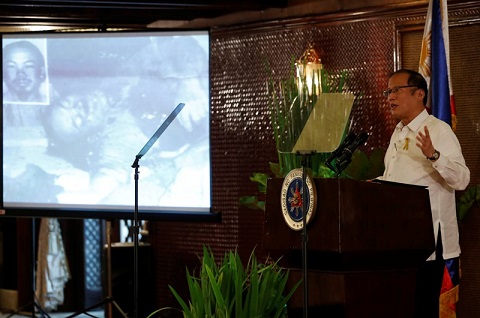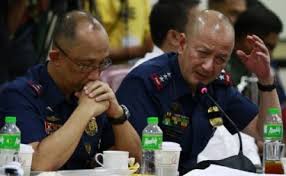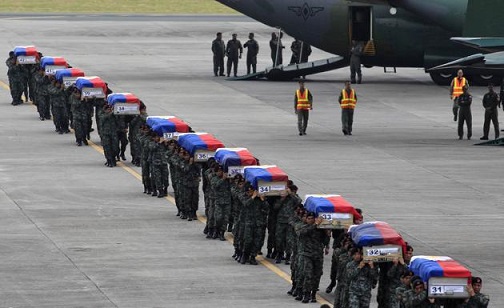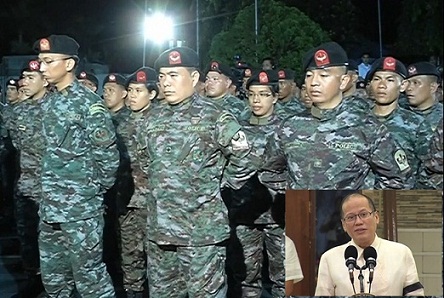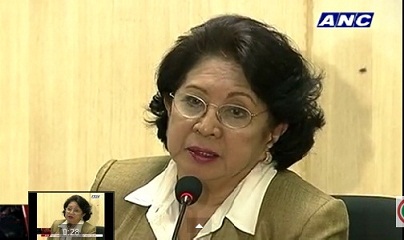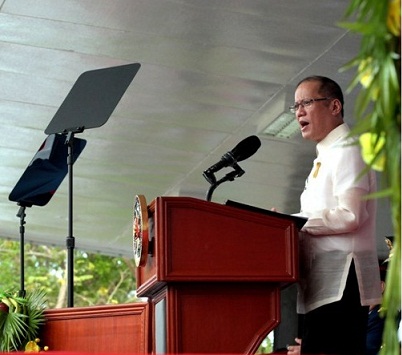
Trillanes being interviewed by Pinky Webb at Mornings at ANC
Following is the transcript of the interview of Senator Antonio Trillanes by Pinky Webb at Mornings at ANC last Friday.
PINKY WEBB: Senator Antonio Trillanes refuses to sign the Senate Committee Report on the Mamasapano. He joins us here in the studio to tell us why. And we will also talk to him about his plans for 2016. Senator, good morning!
SENATOR ANTONIO TRILLANES IV (SAFT): Good morning Pinky.
WEBB: Alright. The Mamasapano Report gathered 20 signatures from your fellow Senators with reservations, half of them with reservations. There are four who didn’t sign, yourself, Senate President Franklin Drilon, Senator Enrile and Senator Lito Lapid. You were quoted saying that the Senate report was lacking.
SAFT: Yes.
WEBB: Yes.
SAFT: It lacked the crucial information particularly the revelations made during the Executive Session and I believe that information would shed light on what really happened on that unfaithful day.
WEBB: The executive sessions. There were the five of them, Sir. Did you attend all five?
SAFT: Yes, I attended all the five, but the past few days since I wasn’t able to secure the consent of the majority to reveal the contents or the revelations during these Executive Sessions, I talked to the resource persons themselves directly, therefore, I’m now authorized to talk about it.
WEBB: Let’s talk about it, Sir.
SAFT: Okay.
WEBB: What was not discussed there?
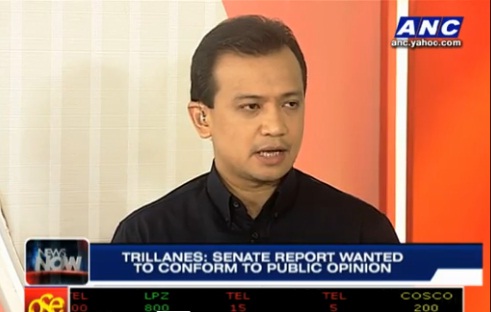
Trillanes at Mornings at ANC
SAFT: The role of the 300 other SAF members, SAF troopers that were deployed in Mamasapano. Questions start with what they did during the calls for help of their comrades. Because before you start pointing your fingers to other units, like the Army or even the President for blame or for not responding, that person should be asked first. What did you do to or did you attempt to rescue your comrades? Well according to the resource persons, they did not.
WEBB: They did not what?
SAFT: They did not respond at all. They were just lying there. Nagre-relax, nakahiga.
WEBB: Senator, wait. These resource people that you spoke to are the members of the SAF.
SAFT: Members of the Armed Forces.
WEBB: The Armed Forces not the SAF. Okay.
SAFT: But they saw for themselves kung ano yung ginawa nung mga SAF troopers. Remember, na-engage yung 55th Special Action Company (SAC) around 6:30am.
WEBB: Nakuha na nila si Marwan. Marwan was dead already at this time.
SAFT: Yes. Around that time, the 55th SAC wasn’t engaged heavily yet. And the 120 blocking forces, the other two companies who were supposed to go to their objectives, didn’t do anywhere near the 55th SAC when they had the chance.
WEBB: So let’s clarify that, Sir. There’s the 84th and the 55th, sino ulit yung unang pumasok sa territory? Was it the 84th?
SAFT: The 84th.
WEBB: Ang blocking force yung 55th?
SAFT: Yes.
WEBB: The 84th was already there and nakikipag-laban na yung blocking force ng 55th. Sabi mo meron pang 100?
SAFT: 120.
WEBB: 120.
SAFT: Mga around 120 SAF troopers who were supposed to be blocking forces also, but at different way points. So these were supposed to go to their objectives but they were not anywhere near their objectives, and they were reporting to the tactical command post of General Napenas that they were engaged in or they were met by heavy volume of fire. But it was not true because they were so far away from the action.
WEBB: So, you were saying that the 120 SAF, the next blocking force after the 55th, did not enter the territory and they lied, and they said that they are under heavy fire when they didn’t close the area, Sir?
SAFT: Yes, and in fact, the reinforcement the Army troopers came they were asking the SAF troopers to go in and reinforce their combats. But the SAF officers said they won’t go in there. There’s so much gunfire and we don’t know the terrain. So, these are revelations na sana nailabas dun sa Committee Report.
WEBB: I hope you don’t mind me saying this, Sir. How sure are you that these Army personnel that you spoke to were actually telling you the truth?
SAFT: Well, yun ang sinabi nila sa Executive Sessions, and we don’t have any reason to distrust them, yun yung revelations. Ngayon, an estimate of the total enemy forces engaged, that engaged the 55th SAC, was around 100 to 120, 100 to 150. Kung nakadikit itong 120 na ito, patas sila, maganda na yung laban. And during the early hours of the encounter they had the chance. Hindi pa napipintakasi. I believe yun yung crucial information dito na hindi nailabas. And later on, may mga ibang evidence na lalabas na yung mga walang sense of urgency, nanduduon lang sa sagingan, yung ibang troopers nasa kalye, by the road. Yung 120, 500 meters from the road side lang sila nakapasok. And nung nag puputukan, they were around 800 to 900 meters away. So, they had all the opportunity to get close to the engaged comrades, their fellow SAF troopers.
WEBB: You heard these in the Executive Session?
SAFT: Yes and I heard it again when I asked these when I spoke to the resource persons.
WEBB: Why did you want to speak to them again?
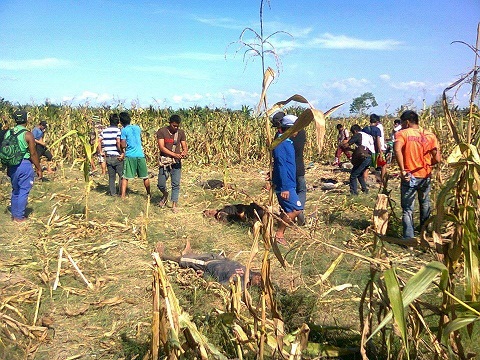
Jan, 25, 2015. Mamasapano, Maguindanao
SAFT: Because I can’t reveal the contents of the Executive Session, all the information we got from the executive sessions, unless I had the consent of the majority, majority consent to its release. But since I wasn’t able to secure that,
WEBB: You spoke to them personally.
SAFT: Yes.
WEBB: So, you can tell us what happened during the Executive Session.
SAFT: Yes, particularly those testimonies.
WEBB: Sir, the 120, that the resource person who how many resource person you are speaking to. Hindi yung sa executive session.
SAFT: All in all, it’s around 5.
WEBB: Lima. Anong oras daw sila dumating dun sa 120 SAF force na ang sinasabi nilang ayaw gumalaw?
SAFT: Around 10am.
WEBB: So, heavy fire, marami pa siguradong buhay at that time.
SAFT: Yes, and the volume of fire was not directed to them at all. So, one of the Army resource persons said that the volume of fire was not heavy, at least based on how they were hearing it from their position. And they could have maneuvred in, they could have advance maneuvred to the left just to get near the 55th.
WEBB: The 55th.
SAFT: And they could have drawn fire and relieved the SAF troopers of the pressure, because the fire would be diverted. There would be suppresive fire or if not they could really out maneuvre them. That’s the testimony of the Army officers. I had to say this; I have to reveal this because I think they are pointing their fingers into so many directions. The thing is we need to focus closely on what really happened.
WEBB: But did you know why the 120 did not want to move in, Sir? What did the Army say?
SAFT: They could speculate, but according to General Napenas, he was directing these people to move in and they were responding that,
WEBB: There were heavy fire and say they couldn’t.
SAFT: So they couldn’t, but when the Army linked-up with them, precisely to reinforce the 55th SAC, they were not engaged at all. And they didn’t even attempt to go anywhere near the 55th.
WEBB: Plain and simple, Sir. What you were saying is that, if I may paraphrase it, the 120 that is supposedly reinforcement to the 55th SAC lied to General Napenas, para hindi po sila makapasok. Is that what you are saying?
SAFT: I’m not going to be that direct, but those are the facts. General Napeñas said he directed his people to engage and they reported back to him that they are met with heavy volume of fire so they couldn’t go anywhere near. But the Army reinforcement, when they linked up with them precisely to reinforce, they wouldn’t want to move. Ang sabi is ‘hindi kami papasok diyan, di namin alam yung terrain diyan. Maraming putukan diyan,’ ganon ang sabi ng SAF officer sa kanila.
WEBB: Would it be possible that maybe there was another group of SAF troopers na inuutusan ni General Napeñas na tulungan yung 55thSAF. Could it be possible that there was another group?
SAFT: Wala. No, it’s not possible.
WEBB: Yung 120, yun lang?
SAFT: Yes, it’s in the plan, the 45th and the 42nd. So those are very crucial information. I would like to believe so because the Philippine Army, for example is being unjustly blamed for not reacting fast enough. But this is the thing, they have their own SAF trooper fellows there, just hundreds of meters away, and didn’t even respond.
WEBB: How far were those 120 SAF troopers from the 55th, Sir?
SAFT: Around 800 to 900 meters.
WEBB: So, less than a kilometre?
SAFT: Yes, but they were supposed to be closer in the first place because,
WEBB: Blocking force sila.
SAFT: Yes, blocking force. And their objectives are in fact go beyond the engagement area were the 55th SAF was found.
WEBB: So, Sir, what the army or what the resource persons are telling you is plain and simple, the 100 SAF troopers gave the wrong information to General Napeñas? Could you conclude that?
SAFT: I don’t know, probably. But the fact remains that when they were asked to engage, even by the army reinforcement, they wouldn’t want to move. They didn’t want to enter in that territory because as they said,
WEBB: Sabi nila, we don’t know the terrain.
SAFT: Didn’t know the terrain and masyadong malakas ang putukan.
WEBB: Okay. Just something that crossed my mind, Sir. Would it be possible that they didn’t want take orders from the Army, Sir? Dumating yung army doon, nakita yung 120 sabi ‘pasukin nyo na yan.’ Maybe, they didn’t want to take orders from them.
SAFT: ‘Papasukin natin’ kasi kasabay sila. Pero regardless, we’re trying to blame all these people why the reinforcement didn’t come, but meron naman. They’re just hundreds of meters away.
WEBB: Well, you know, some people quite frankly have been asking what happened to the rest of SAF troopers? As a matter of fact, way back, there was a report by Chiara Zambrano that there were SAF troopers supposedly on the road tapos nadaanan ng mga Army. That’s why you know, nagkaroon po ng sakitan ng loob, palitan ng accusations. Because of that information senator, who’s responsible for that?
SAFT: Well, General Napeñas was the overall commander of this operation. So, I think, ultimately, he needs to answer for that. And the problem right now, I think in the Committee Report, they wanted to conform the Committee Report with the public opinion and the media angle that’s prevailing right now and didn’t want to touch the SAF because they have glorified the SAF as a unit up to this point. But don’t get me wrong, the 44 who perished, even the survivors of the 84th are heroes. They did their job. They accomplished the mission. But what about those companions who were there, just hundreds of meters away, what did they do? They just lied by the river. They lied down there, nag-tetext pa nga daw yung iba. There was no sense of urgency at all.
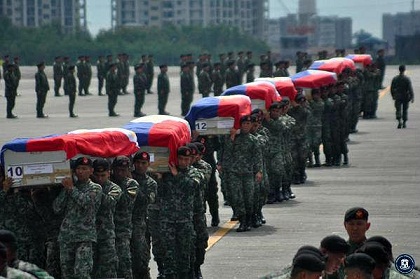
Bodies of slain SAF arrive at Villamor Airbase. Malacanang photo
WEBB: So, in a situation like that, where does the fault lie? Who’s to blame? Si General Napeñas, I mean you said that it’s possibly General Napeñas. But if it is true that the 120 gave General Napeñas wrong information, that being met with heavy fire, anong gagawin naman ni General Napeñas? Just like the President, saying he was being fed wrong information by General Napeñas. I mean, how do you reconcile that?
SAFT: Well, at the very least, General Espina right now, as the Chief PNP, should investigate the matter. Because sa Armed Forces, we have the Articles of War. Worse, it costs so much controversy and, national anger and pain, when we could actually have prevented it. Ang information is 100 to 150 MILF and other enemy forces engaged.
WEBB: Total sir?
SAFT: Yes, the 55th. And you have 120 here, who didn’t even but were supposed to be, they could have gotten as close to less than a hundred meters, based on the testimonies.
WEBB: So, ganon pala iyon. They should have been at least a hundred meters away from the 55th.
SAFT: Yes.
WEBB: If that is true, I’m not saying it isn’t, let me ask you this, why was that not included in the Senate Report when it seems to you that it is a very crucial point that needs to be understood by everyone or at least, discovered and found out by everyone? What’s so confidential about that?
SAFT: Nothing. But I think, like what I said, the writers of this Committee Report were so conscious of the public media opinion that glorified the SAF. They glossed over it.
WEBB: So sinadiya? You’re saying?
SAFT: No, not really. Subconsciously, they wanted to align their Committee Report with that of public opinion. They didn’t want to.
WEBB: They chose to turn a blind eye on that revelations, particular revelations?
SAFT: Not really choosing to turn a blind eye, but they glossed over it.
WEBB: Pinabayaan nalang?
SAFT: Probably. They wanted to present other things that would make people happy and the media people happy. But as I said, we’re not here for that. We’re not here to entertain everyone.
WEBB: But why did you say that that would be something the media people would be happy about? I mean we were just waiting for that report.
SAFT: Yes. But there’s already a clamour, the direction or agenda that the Senate report should and must include, and must focus, is on the liability and responsibility of the President.
WEBB: Okay. So, one point you raised with what we discussed is that do you see lacking information that shouldn’t have revealed in public in the report. So obviously, that’s a reservation on your part. Definitely, that’s why you didn’t sign it, kasi kulang. You called it lacking in information. Directly Sir, is the President at fault because of the Mamasapano incident? You know, let’s get a categorical answer because sometimes it gets very confusing with the BOI report. Sa inyo, was he at fault?
SAFT: Okay, we need to clarify and qualify that. With responsibility, there’s no debate about it and the President has already admitted or accepted full responsibility for the debacle in Mamasapano. But if we’re going to pinpoint accountability, we have to be more precise because we want to avoid this thing from ever happening in our country. So that’s how we should approach this investigation. This is not a political game. It’s going to be very convenient to pin the blame on the President right now, because he is quite popular. It’s very easy for politicians to just sign Committee Report because they perceive this to be the popular thing to do. But I believe it’s also our obligation to bring out the truth. And this is the truth. And nobody wanted to get anywhere near touching the SAF in this light, right? Because the SAF now has been glorified. Well in the case of those who perished, the SAF 44, its likely so. They deserve it and including the survivors. But those who were just lying around when their comrades were being massacred, I don’t think they deserve to be glorified.
WEBB: So, who’s to blame? Because, how I understand it Sir, there is a difference between someone being responsible and someone being accountable. The President is responsible, Sir, that’s what you’re saying. Is he accountable?
SAFT: No.
WEBB: Who is accountable?
SAFT: General Napeñas, he’s the overall commander. That’s how it is. In military operations, you get casualties but the results of your mission will dictate whether you deserve to hold command or not. In this particular case, there are so many flaws, even during the planning, even during the execution and based on the information I’ve been getting, it is a total breakdown of leadership a discipline. In fact, during the investigation, General Napeñas couldn’t even explain why the blocking forces, the other companies, left so much later. The jump-off time was supposed to be a couple of hours before.
WEBB: This is the 42nd and 45th?
SAFT: Including the 55th.
WEBB: Ah, okay.
SAFT: And the mission hinge, the success of the mission hinged on the cover of darkness.
WEBB: I know, Sir. I did hear about that, ang plano pala was to come in and finish the operation before sunrise.
SAFT: Yes.
WEBB: That was the plan.
SAFT: Yes.
WEBB: So, they got Marwan at five?
SAFT: Mga 4:30.
WEBB: 4:30 and then, obviously the fighting went on for a couple of hours. Some were saying that as commander, there should have been such a thing as ‘abort mission’. Let me ask you this, in terms of the plan, was it sufficient? The implementation, extrication, I mean give us your thoughts on that. Yung plano pa lang, Oplan Exodus itself.
SAFT: Yes. It’s even stated in the BOI and the Senate Committee report, it’s unanimous. The plan was flawed. There are so many ways you could have done it and be successful and have minimal casualties, but General Napeñas chose this. The execution was even worse. The jump-off time was delayed, that’s inexcusable for military AFP unit. If the jump off time is 22:00, you leave at 22:00. It’s not,
WEBB: It’s not a minute later.
SAFT: It’s not a minute later. Then, there are other revelations there, to include that some of the Commanders of the Army were wined and dined by some PNP intelligence officers the night before just to make sure they won’t operate. So those are very,
WEBB: Who wined and dined?
SAFT: The commanders of the army.
WEBB: So.
SAFT: The Ground Commanders of the Army.
WEBB: Yes, para ano? Para makatulog sila, hindi sila makialam? Ganoon ba?
SAFT: Yes, to determine if they have a mission there or not.
WEBB: To determine. I mean they are being wined and dined para to keep them monitored?
SAFT: Yes, to ensure that,
WEBB: Hindi sila gumagalaw.
SAFT: Yes.
WEBB: I see. How many of them are wined and dined? And where were they wined and dined?
SAFT: Simpleng inuman lang iyon.
WEBB: Yes, I know what you mean, Sir. Para bang hinostage sila pero pina-inom at pinakain. Parang ganoon pero hindi nagmumukhang mino-monitor. When was this?
SAFT: It was a distraction, so it was done the night before.
WEBB: Prior to the jump-off?
SAFT: Yes, the night of the jump off.
WEBB: Oo nga, yes.
SAFT: So yun. Maraming ganoon.
WEBB: But when you say Army Commanders na you know… sige, tanggalin na natin yung wined and dined kasi iba yung…
SAFT: Hindi, they were invited na mag-happy hour, anyway it was a weekend o after office hours, so sige.
WEBB: Sino nag-imbita sa kanila, Sir?
SAFT: One of the intelligence officers from the PNP.
WEBB: One, not the one that’s already being mentioned.
SAFT: No. So, may mga ganoong information. Because of politics again, dinala nila tayo, umabot na tayo sa Malacañang, pero dapat dito tayo naka-focus. Kasi dito pa lang makikita na natin yung sagot dun sa tanong, who was responsible for the deaths of the SAF 44? Again, it’s around to a hundred to one hundred fifty MILF troops. They were three hundred. They could have outnumbered them if they just went it.
WEBB: At that particular time.
SAFT: So, ako I’m going to,
WEBB: What are you planning to do?
SAFT: I’m going to ask General Espina to investigate this matter dahil misleading. May wrong impression created because of the early media play that we totally glossed over. And right now, I believe I have to,
WEBB: But that would not be the fault of the media if the Senate glossed over this. This is ultimately the responsibility of the Senate, Sir, the Senators. Kayo yung nandoon sa Executive Session.
SAFT: Which is why I didn’t sign it, because we’re going to create that. This was the best opportunity for us to correct that wrong impression made early on, but they we’re fearing a possible backlash so why not just feed this to the gallery and let us be cheered on by the people.
WEBB: Senator, when this whole Mamasapano incident came about, of course being part of the Navy, what was the first thing you thought of? Ano yung, syempre diba Sir, you’re a military guy, ano yung una mong naisip nung nangyari to? What were your first thoughts?
SAFT: I think I was one of the first who was interviewed about this incident, here also in ANC. I said, ‘For now, while I would want to wait for more information, my question is why didn’t the PNP coordinate with the AFP?’ That was very crucial. So then we found out that the,
WEBB: But dumating sa isip niyo Sir yung mismatch? Yung sinasabi mo nga na there were 392, ilagay na natin sa 400 SAF troopers, Sir, did that bother you? Was that something in your head that, ‘anong nangyari dun sa 392 kung may apat na’?
SAFT: Yes, but that came in a few days.
WEBB: A little later.
SAFT: A little later when we found out that only around 80 or 90 were engaged and the others were blocking forces and security. So, those questions arose, but during the investigation especially during the Executive Sessions, just to give credit to the army, they didn’t want to reveal this in the open session. They didn’t want to because it would put the SAF in the bad light and they didn’t want that. But the sad thing, General Napeñas kept on pointing to the military.
WEBB: Well, in fairness, he keep saying that, “Kasi sana nagkaroon ng reinforcements sa military.” Madalas niyang masabi yon.
SAFT: Yes, pero meron nga. And yun na nga, bakit ka hihingi ng reinforcements sa AFP when you already have them within your unit?
WEBB: To conclude it, Sir. Okay, number one, what could be done about it? You’ll ask PNP OIC General Espina to investigate this. Number two, Sir, this whole Mamasapano incident, you already said, the President is ultimately responsible but the deaths of the 44, you’re saying should not be blamed on the President but should be blamed on Napeñas?
SAFT: No.
WEBB: Hindi, okay.
SAFT: Hindi po. We’re talking about the deaths of the 44 should be blamed to those who killed, the blame for that should be directed to those who actually pulled the trigger. And that’s the MILF, BIFF, and the other private armed groups. But just analyzing what I just said, baka hindi namatay, baka nanalo pa sila kung pumasok yung 120.
WEBB: That’s why I wanted to rephrase that question because when I asked you who’s to blame for this, you said General Napeñas. So, what is the accountability? What can we blame on General Napeñas, Sir?
SAFT: By the nature of military operations, you cannot attach any criminal liability to a Military Commander. If he committed gross negligence or any service related offenses, the most that you can impose on him is an administrative punishment.
WEBB: But that’s the military.
SAFT: That’s the military and the police because the nature of this is military operations.
WEBB: Okay, okay.
SAFT: Because you can’t punish military commanders for any casualty, otherwise, no military commander would conduct military operations. But I think the finger pointing should stop. Again, I go back in my initial assertions. General Napeñas should just man up and accept full responsibility and liability for the debacle of the Mamasapano incident. The Army Officers I believe, the Army in general, did everything.
WEBB: And you’re not biased?
SAFT: No, I’m not. In fact, I am being objective as I could. In fact, I came in with that bias and sympathy for the SAF. But when the information came to me clinging in, that impression changed. Now, remember General Napeñas kept on saying that he gave grid coordinates, and he was texting them and he showed the text messages as proof. When these were actually plotted, none of them were accurate.
WEBB: Mali?
SAFT: Yes. Mali.
WEBB: So, where did those grid coordinates come from?
SAFT: I wouldn’t know. So, plinot iyon.
WEBB: What you’re saying is, even if he passed on those grid coordinates to everybody, to the military for example, and ginamit nila yung grid coordinates na iyon, they would have been in a place where the fire fight was not happening?
SAFT: Yes.
WEBB: They would have been in a wrong place?
SAFT: And it could have killed the friendly forces, for all we know. And in fact, one of the grid coordinates given was the withdrawal area for the 84th Company, so it’s totally erroneous. In fact, in one of the text messages I pointed out, General Napeñas texted 365 degress, there’s no such thing.
WEBB: Sorry, I don’t know anything about grid coordinates.
SAFT: No, but it’s up to 360 degrees, right?
WEBB: 360 nga lang, hindi pwedeng sumobra pa.
SAFT: This information is not actionable. Well, it’s just a sample. But all the grid coordinates given by General Napeñas didn’t match anything in the engagement area.
WEBB: Yes, but could it have been right yung sa withdrawal force ng 84th?
SAFT: No.
WEBB: Hindi, sabi mo there was one grid coordinate that kung saan yung withdrawal ng 84th. That’s not a bad grid coordinate, right?
SAFT: Yes. Pero kapag kinanyon mo iyon, eh di pag nag-withdraw sila, tatamaan sila.
WEBB: Ay sorry, hindi ko naman naisip iyon.
SAFT: It’s a friendly force. And they were using Google maps which is not the standard military tactical map. So when they were trying to match it, hind talaga (magtutugma.)
WEBB: What do you use as maps?
SAFT: May military tactical maps, pati yung mga elevations, so mas detailed iyon and coordinated kayo, you won’t miss out.
WEBB: So, they used Google maps. But what normally would the police use, the same map as the military?
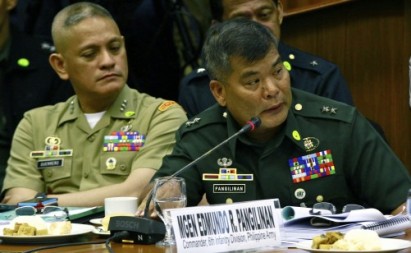
Maj. Gen. Edmundo Pangilinan,commander of the Philippine Army’s 6th Infantry Division, at the Senate hearing. With him is Lt. Gen. Rustico Guerrero, chief of AFP Western Mindanao Command.Photo from Interaksyon.
SAFT: I would like to believe that they have tactical maps as well. But the one that they brought to the Army headquarters was Google maps. And the officers, the SAF officers, were being asked by the Army commander, the coordinates for the friendly forces and the enemy forces, they couldn’t give anything. But in public, General Napeñas was saying ‘my officers were already dead, we’re coordinating.’ Yes, they were talking, but they couldn’t pinpoint the exact location of the friendly forces and the enemy forces. Therefore you cannot use the artillery, the fire support.
WEBB: Correct, correct, I understand.
SAFT: But again, the public impression, because they gave so much credence to the greatness of General Napeñas, everybody bought it, it’s now the fault of the Army.
WEBB: So, you believe when the President said that binola siya ni Napeñas?
SAFT: Yes.
WEBB: Naniniwala kayo doon?
SAFT: Hindi lang si Presidente ang binola niya, pati mg Senador, and the public. He’s taking everybody for a ride because he can’t accept that responsibility. Namatay yung mga tropa mo kasi mali yung plano, mali yung execution mo.
WEBB: So you said that the responsibility is Napenas’, the accountability is Napeñas’ kung i-tatagalog natin iyon, Sir, ang responsibiliadad ay kay Napenas, at ang.. Kasi hindi natin pwedeng… parang nung sinabi ko “Kasalanan ba’to ni Napenas? Sabi mo, hindi.” You said “I wouldn’t say that.”
SAFT: No. Ang pinag-uusapan kasi natin yung pagkamatay nila, yung pumatay sa kanila. Ang pumatay sa kanila (yung MILF, yung BIFF). Pero what placed them in that situation na mamatay was General Napeñas. He could have again given all the flaws of the plan kung na-impose niya ang kanyang leadership sa kaniyang mga tao, na-compel niyang pumasok iyon at dumikit sa 55th SAF. And they could have been, they could have actually won that particular skirmish.
WEBB: Very quickly Sir, still on this topic, you said that the President should not say sorry.
SAFT: Yes.
WEBB: Why? I mean you said that he’s responsible?
SAFT: Yes. Well, let’s just say that the nature of an apology should be given voluntarily.
WEBB: Kusa?
SAFT: Kusa. Yung “bukal sa kalooban”. If it’s not, if it’s extracted from you, or if it’s forced, then it has no value at all, right? I was saying that, in that sense. And look, in that apology, would that please the relatives? No. They want more, right? They want justice.
WEBB: But that’s what Senator Grace was saying. Di ba sabi niya “kahit paano mapapawi yung sama ng loob, yung ganun…” But she said there are a number of things that the President needs to do: take care of the widows, etc., put to justice those who are responsible to the crime. But as the father of the nation, as the father of the SAF 44 that were killed, when you say he’s responsible, you don’t apologize at sabihing kasalanan mo but you apologize for what has happened. I mean mahirap bang gawin iyon?
SAFT: I agree. But these are social skills. We cannot impose our own standards for social demeanour to anybody, right?
WEBB: If that was you, would you have apologized? If you were the President.
SAFT: Well, privately, I would have conveyed a message to make sure that the relatives would feel that there is a sense of compassion. But we can set that aside now because an apology wouldn’t be sufficient for the relatives, it wouldn’t be sufficient for the critics, for the ambivalent majority, they wouldn’t care either way. And for the critics, they would even use it, probably, as basis for an impeachment because it’s an admission of guilt.
WEBB: So that’s why you were saying, you’re advising the President not to fall into that trap of saying sorry.
SAFT: Because I remembered, during the time of GMA, remember she said “Sorry”? Did we buy that? Were we appeased by that? No. In fact, we even intensified the protest because that’s practically an admission of guilt.
WEBB: But Senator, would that be a fair comparison to compare the “I am sorry” of the former President and a possible “sorry” of PNoy? These are two different situations and two different incidents that happened, ‘di ba?
SAFT: I know. But they’re trying to link it with a liability and accountability. So, if an expression of apology or regret should be given to the relatives, they can do it privately. But let me just redirect this conversation again. Yung mga kamag-anak, they feel so bad, they want justice. They could have gotten that justice kung yung mga kasamahan nilang SAF ay ginawa yung trabaho nila. Yung kay General Espina, his calls for justice, he could have gotten that right there and then, kung yung mga tropa nila na SAF, na 120 and another 100 plus here, eh pumasok.
WEBB: Were you able to speak to General Espina already, Sir, o hindi pa?
SAFT: No, not yet. I was waiting for this Committee Report to reveal that. It is a revelation by the Senate as an institution. But we missed it, it’s sad.
WEBB: Well, you shared it with us, Sir. I guess we know what happened, at least parts of what happened during that Executive Session because you were able to get consent from the resource persons, Sir. So, how do you suggest that the President move on, if you don’t feel he shouldn’t apologize and fall into that trap?
SAFT: I guess there are so many lessons learned in this episode. But for now, in the short term, they should really communicate well with the public, because there’s confusion, there is a deliberate misdirection and they should take control on the flow of information right now, not in the Draconian sense. But they should be more proactive in the delivery of their communications.
WEBB: Okay, one last question on this topic. Yes or no, was it right that the President still included the suspended PNP chief during the operation of Oplan Exodus?
SAFT: It wasn’t, but again, just looking at the context of their relationship. General Purisima and the President, go way back during the 80’s. They are friends, advisers, confidants, so, in the suspension of General Purisima, that didn’t include being suspended as a friend, adviser and confidant, right? And he was doing it in a private channel which is a text message in mobile phone.
WEBB: Sir, he was part of the meeting.
SAFT: Yes.
WEBB: It was the President, it was Purisima, it was Napeñas. There was no Espina. There was no Mar Roxas there.
SAFT: Yes, but it was already approved the year before.
WEBB: Yes, but not the timeline, Sir. Hindi yung araw of the operation. I mean, one month before they met there, one month before that General Purisima was suspended. I believe that’s December 9 or December 4. Sinama pa rin nya. Okay, you’re saying there’s nothing wrong with that, di ba? Kasi kaibigan nya itong matagal at siya yung on top, pero the President kept communicating to General Purisima about this the whole time when he is suspended. Okay, is that a big deal for you? Parang hindi e.
SAFT: You know why? Sabi ko nga, we’ll go back to the plan, even if the President was continuously communicating with General Purisima, but if the mission was successful and we don’t have any casualties there, would that matter?
WEBB: Well, we wouldn’t have known, but that’s the problem, Sir.
SAFT: Yes.
WEBB: Something happened, that’s why we found out.
SAFT: But this is a covert operation to begin with. And General Purisima was privy to that covert operation. Probably the lapse of the President was he could’ve included General Espina but he didn’t, so, it’s a lapse.
WEBB: Alright.
SAFT: But right now.
WEBB: Lapse in judgment.
SAFT: It’s a lapse in judgment, but still, iyon bang communication nila ang dahilan kung bakit namatay yung 44?
WEBB: I understand where you’re going with this, Sir. So, you declared that you will run, on to the next topic, as Vice President in 2016. Many times we’ve talked, Sir, you’ve always told us your intention to run. But I guess, this is as clear as your announcement yesterday.
SAFT: Yes.
WEBB: What made you finally decide to tell everyone that you are running for Vice President in 2016? Pending, of course the nomination of your party.
SAFT: Well, for some reasons, it was never intended. I was there during that press conference for the Mamasapano Report, but I was asked by the same question, but I guess it was more specific, so I just answered. And it’s now out there. But it’s a personal decision for now. I would still submit to the decision of the Nacionalista Party. And I guess, I just have to start preparing later on about what I will show off to my countrymen as regards my qualifications for that position.
WEBB: You declared, you know, your intention to run for Vice President. Are you, you know, wary or are you thinking that possibly, there could be some investigations about you because you already told the people or the public your intention to run for vice president? I guess, what I’m saying is similar to Vice President Jejomar Binay, Sir.
SAFT: Yes, well, that’s part of it. You’ll have to be prepared for that. I’ve been through worse, so, bring it on.
WEBB: I mean, there could be possible corruption charges, you think filed against you? Is everything in your SALN, Sir?
SAFT: Yes.
WEBB: You have no bank accounts abroad?
SAFT: None.
WEBB: You don’t have property abroad, Sir?
SAFT: No, I don’t have any Hacienda Binay type of properties.
WEBB: So, you’re ready for that. If you were to choose lang, Sir, who would be the President? Who would probably have the most, yung pareho kayo ng idealismo, ng paninindigan, sino iyon for you?
SAFT: For the Nacionalista Party?
WEBB: Anybody, Sir? Sabihin na natin, if you were to choose a President, which is hindi naman po, siyempre baliktad din naman yun. Sino yung pinaka parang in-line with your thinking, sa inyong paninindigan, your stand, everything, Sir?
SAFT: Let’s just say there’s an array of names being floated around and personalities, I’ll start with my party, we have Senator Manny Villar, Senator Alan Cayetano, Senator Bongbong Marcos. You have Senator Grace Poe, you have Secretary Mar Roxas. So, all these people are very much competent. You have Mayor Duterte even, and I think Senator…
WEBB: Sino yung pinakabagay sayo to be your president, if you were to run as vice president?
SAFT: I’m really not prepared for that, but it would be best if it would be from the same party, so that,
WEBB: But, you’re talking about your core party or a party that could enter a coalition, Sir? Isa sa core party ninyo? It would just be Senator Alan Cayetano and Senator Bongbong Marcos, and Senator Manny Villar? Silang tatlo lang po?
SAFT: Yes.
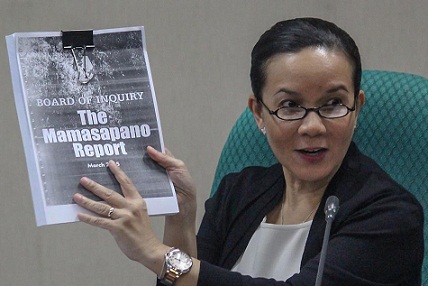
Sen. Grace Poe reveals findings of Senate committee that investigated Mamasapano tragedy.
WEBB: Senator Grace Poe is not? Secretary Mar Roxas is not either? So, sabi mo sana isa doon sa tatlo?
SAFT: Yes, but again, if the party decides to form a coalition again, let’s say with the Liberal Party, then, I believe we don’t have any chemistry issues, because right now, we’re still in a coalition. And Secretary Mar Roxas, I believe is a decent public servant and he embraced the programs of the President, so, transition won’t be a problem with that regard.
WEBB: Yes, if you are going to run, your party chooses you as the vice president, who would be, yung pinakamahirap mong kalaban?
SAFT: As vice president, probably it’s Senator Chiz Escudero.
WEBB: Can you beat him, Sir?
SAFT: The people would be able to answer that.
WEBB: But right now, who would you feel has the upper hand between you and Senator Chiz? Ngayon?
SAFT: It’s definitely Senator Chiz Escudero.
WEBB: Would this be your last term? Ito na po ba or you still have 3 years or another term?
SAFT: I will have another 3 years.
WEBB: In 2016?
SAFT: Yes.
WEBB: So, if you lose, balik kayo ng Senado?
SAFT: Yes.
WEBB: So, not much to lose.
SAFT: Well.
WEBB: Well, what pride?
SAFT: Yes.
SAFT: Nothing. But I think, like what I said, the writers of this Committee Report were so conscious of the public media opinion that glorified the SAF. They glossed over it.
WEBB: So sinadiya? You’re saying?
SAFT: No, not really. Subconsciously, they wanted to align their Committee Report with that of public opinion. They didn’t want to,
WEBB: They chose to turn a blind eye on that revelations, particular revelations?
SAFT: Not really choosing to turn a blind eye, but they glossed over it.
WEBB: Hindi ba, that’s something, siguro sa pagkakilala ko rin sa inyo, kailangan sigurista ka. I mean, for you to run Sir, how I’ve always known you is that, your chances should be big talaga.
SAFT: Well, at least, there’s a chance. Remember, when you interviewed me, I think in Fort Bonifacio, nobody gave us a chance but we saw a little chance there, so, we went for it.
WEBB: That’s true. I remember your campaign started in a garage somewhere in Makati. But, we wish you luck Sir, and again, you know, at least that’s a revelation for us, for the people, for the public, those who were tuning in right now, the revelation of the army on what happened last January 25. Something you shared with us, of course, may permiso, with the permission of the 5 army personnel that you spoke to who were witnesses during Mamasapano encounter. Senator, thank you so much for joining us and good luck, Sir.
SAFT: Thank you Pinky.
